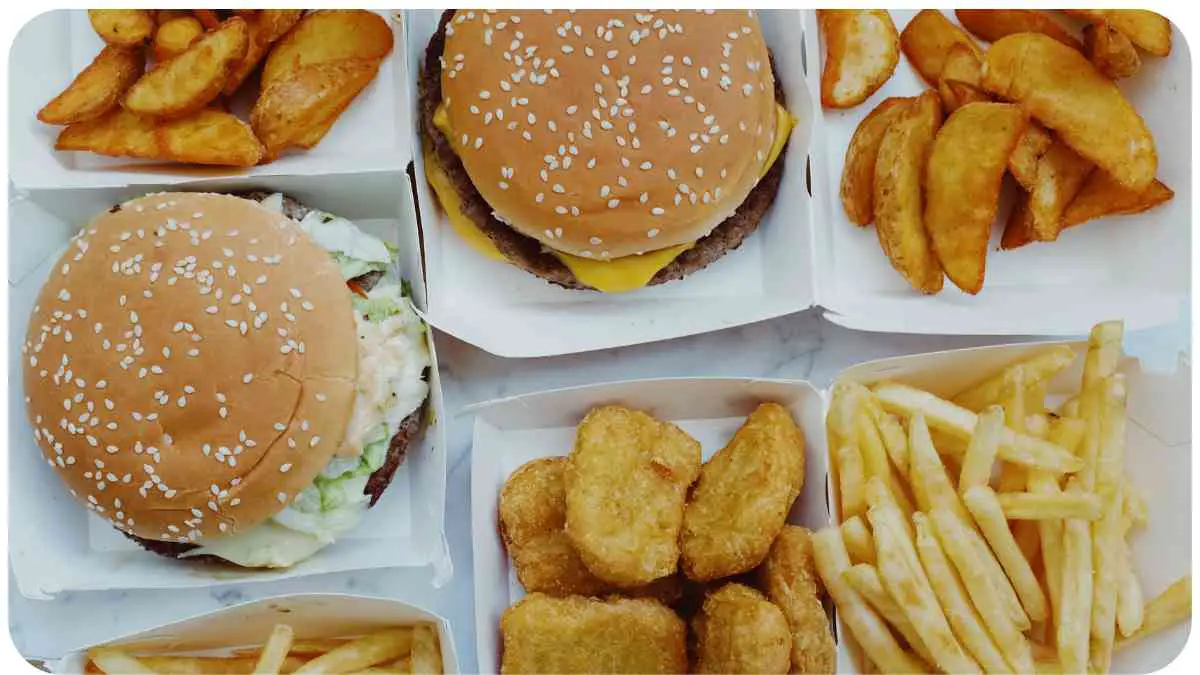Welcome to this comprehensive guide on understanding the basics of food portion sizes. In this article, we will explore why portion sizes matter, techniques for portion control, the impact of portion sizes on weight management and nutritional balance, and practical strategies for maintaining portion control even in social settings.
Understanding proper portion sizes is crucial for maintaining a healthy lifestyle, and we will provide you with the knowledge and tools to make informed choices about the quantity of food you consume.
| Takeaways |
| Understanding portion sizes is crucial for weight management and nutritional balance. |
| Mindful eating and portion control go hand-in-hand, promoting a healthier relationship with food. |
| Practicing portion control can be challenging but can be overcome with mindful strategies. |
| Paying attention to children’s portion sizes is important for their growth and development. |
| Further reading resources provide additional information and tips for portion control. |
Why are Portion Sizes Important?

Portion sizes play a significant role in maintaining a balanced and nutritious diet. Consuming appropriate portion sizes helps ensure that you consume the necessary nutrients without overeating. Proper portion sizes promote weight management, prevent overconsumption of calories, and help you maintain a steady energy level. Additionally, being mindful of portion sizes can assist in avoiding nutrient deficiencies and imbalances.
In order to simplify your home cooking and make the most out of your meals, it’s essential to master the art of meal planning. Check out our Ultimate Guide to Meal Planning – Simplify Your Home Cooking for practical tips, tricks, and strategies to save time and effort in the kitchen.
Recommended Portion Sizes for Different Food Groups
To understand portion sizes effectively, it is essential to know the recommended serving sizes for different food groups. The table below summarizes these recommendations:
| Food Group | Recommended Portion Size |
| Grains | 1 ounce |
| Proteins | 3 ounces |
| Fruits | 1 cup |
| Vegetables | 1 cup |
| Dairy Products | 1 cup |
Understanding Serving Sizes
It’s important to understand that serving sizes and portion sizes are not always the same. Serving sizes are standardized measurements used to determine the nutritional content of food. On the other hand, portion sizes refer to the amount of food you choose to consume at a given time. While serving sizes provide a benchmark for understanding nutritional information, portion sizes are more flexible and can vary based on individual needs and goals.
Are you looking to shed some extra pounds? Our Ultimate Guide to Meal Planning for Weight Loss provides expert advice and meal planning strategies that will help you achieve your weight loss goals while enjoying delicious and nutritious meals.
To help you visualize common serving sizes, here is a table that outlines some typical portion sizes:
| Food Item | Serving Size |
| Cooked Pasta | 1/2 cup |
| Grilled Chicken Breast | 3 ounces |
| Apple | 1 medium |
| Mixed Salad | 2 cups |
| Yogurt | 6 ounces |
Understanding serving sizes can help you gauge how much you should be eating and make more informed choices when it comes to portion control.
Portion Control Techniques and Tips
Maintaining proper portion sizes can be challenging, especially when faced with tempting foods and large portions. However, there are several effective techniques and tips you can utilize to keep your portions in check:
- Use smaller plates: Opt for smaller plates and bowls to create the illusion of larger portions. Psychologically, this helps you feel satisfied with smaller amounts of food.
- Measure your food: Use measuring cups, spoons, or a kitchen scale to accurately measure the amount of food you’re consuming. This can provide valuable insights into portion sizes and help you develop a better understanding of appropriate amounts.
- Be mindful of your hunger and fullness cues: Pay attention to your body’s signals of hunger and fullness. Eat slowly and stop eating when you feel comfortably satisfied, rather than overly full.
- Fill up on vegetables and fruits: These foods are low in calories and high in nutrients, making them a great choice for filling up your plate. Aim to make half your plate vegetables or fruits for a well-balanced meal.
- Plan your meals and snacks: Planning ahead can help you avoid mindless eating and make healthier choices in terms of portion sizes. Pre-portion your meals and snacks to prevent overeating.
- Get support: Share your portion control goals with a friend or family member who can provide encouragement and hold you accountable. Consider joining a support group or seeking professional guidance if needed.
For more detailed table that provides additional portion control techniques, refer to the table below:
| Technique | Description |
| Visualize portions | Use visual cues, such as comparing food sizes to familiar objects |
| Portion control tools | Utilize portion control plates, bowls, or containers for easy measuring |
| Practice mindful eating | Focus on the sensory experience of eating, paying attention to each bite |
| Limit liquid calories | Be mindful of high-calorie beverages and opt for water or unsweetened tea |
| Share meals when dining out | Splitting a dish with a friend or family member helps control portion sizes |
Portion Sizes and Weight Management
Understanding the relationship between portion sizes and weight management is crucial for achieving and maintaining a healthy weight. Consuming larger portions than your body requires can lead to a calorie surplus, which can contribute to weight gain over time. On the other hand, consistently consuming appropriate portion sizes can help manage and even reduce body weight.
It’s important to note that portion control is not about strict dieting or deprivation; it’s about creating a healthy balance. By being mindful of portion sizes, you can enjoy a variety of foods while still managing your weight. Here is a table that demonstrates the connection between portion sizes and weight management:
For busy individuals who struggle with finding time to cook, we’ve got you covered. Discover our Busy Person’s Guide to Meal Planning and learn how to efficiently plan and prepare meals that suit your fast-paced lifestyle.
| Portion Size | Impact on Weight Management |
| Oversized portions | Increased risk of overeating and weight gain |
| Appropriate portions | Supports weight management and balance |
| Smaller portions | Promotes weight loss or weight maintenance in calorie deficit |
Portion Sizes and Nutritional Balance

Alongside weight management, portion sizes also play a vital role in achieving nutritional balance. Balancing the types and amounts of foods you consume is essential for obtaining the necessary nutrients while avoiding excessive intake of certain foods. Proper portion sizes ensure that you include a variety of foods in your diet, maintaining a well-rounded nutritional profile.
Here is a table that illustrates the relationship between portion sizes and nutritional balance:
| Portion Size | Impact on Nutritional Balance |
| Oversized portions | Increased risk of consuming excess calories and imbalances in nutrients |
| Appropriate portions | Supports a balanced diet with optimal intake of essential nutrients |
| Smaller portions | May require careful planning to ensure adequate nutrient intake |
Portion Sizes when Dining Out
Maintaining proper portion sizes becomes particularly challenging when dining out at restaurants, where the serving sizes tend to be larger than what we actually need. However, with some awareness and smart choices, it is possible to enjoy a meal outside while still managing portion control.
Consider the following table that provides insights and tips on portion sizes when dining out:
| Tips for Portion Control when Dining Out |
| Share a meal with a friend or family member |
| Opt for smaller portion sizes or half portions, if available |
| Request a to-go box at the beginning of the meal to pack leftovers |
| Fill up on a side salad or vegetable-based appetizer |
| Choose grilled or steamed options over fried and heavily sauced dishes |
By being conscious of your choices and employing these tips, you can navigate portion sizes when dining out without sacrificing enjoyment or derailing your healthy eating habits.
Overcoming Challenges with Portion Sizes
Navigating portion sizes can present its own set of challenges. Factors such as emotional eating, food cravings, and external influences can make it difficult to maintain portion control consistently. However, with a mindful and proactive approach, these challenges can be overcome. Consider the following tips to help you overcome portion size challenges:
- Tune in to your hunger and fullness cues: Listen to your body and eat when you are truly hungry, not based on external triggers or emotions.
- Practice portion control at home: Get in the habit of measuring and portioning your food at home to establish a better understanding of appropriate amounts.
- Identify and address emotional triggers: Find alternative ways to cope with emotions or stress that don’t involve using food as a source of comfort.
- Seek professional guidance: If portion control challenges persist, consider consulting with a registered dietitian or nutritionist who can provide personalized strategies and support.
For more tips on overcoming portion size challenges, refer to the table below:
| Challenge | Tips to Overcome |
| Emotional Eating | Find alternative coping mechanisms and develop healthier habits |
| Food Cravings | Distract yourself with other activities or choose healthier alternatives |
| Social Pressure and Peer Influence | Communicate your goals and preferences to friends and family |
| Lack of Awareness | Educate yourself on portion sizes and practice mindful eating |
The Importance of Mindful Eating
In addition to portion control, practicing mindful eating can further enhance your relationship with food and help you make conscious choices regarding portion sizes. Mindful eating involves paying attention to the sensory experience of eating, being present in the moment, and cultivating a non-judgmental awareness of your food choices.
By engaging in mindful eating, you can develop a deeper understanding of your body’s hunger and fullness cues, making it easier to navigate portion sizes. It allows you to savor your food, appreciate the flavors, and recognize signs of satiety. Mindful eating helps create a healthy mindset around food, promoting a balanced and intuitive approach to eating.
If you’re new to meal planning, our Beginner’s Guide to Meal Planning is the perfect resource to get you started. Learn the basics of meal prepping, creating balanced menus, and optimizing your grocery shopping for successful home cooking.
To incorporate mindful eating into your daily routine, consider the following practical strategies:
- Slow down: Take your time to chew each bite thoroughly and savor the taste of your food.
- Eliminate distractions: Minimize distractions such as phones, computers, or television while eating to focus on the experience of eating.
- Pay attention to hunger and fullness: Before and during a meal, check in with your body to identify your hunger and fullness levels.
- Notice flavors and textures: Appreciate the variety of flavors and textures in your meals, enhancing the satisfaction you derive from them.
- Practice gratitude: Cultivate a sense of gratitude for the food you are consuming and the nourishment it provides.
For a comprehensive table that outlines practical strategies for mindful eating, refer to the table below:
| Strategy | Description |
| Eating with all senses | Engage all your senses to fully experience and enjoy your meal |
| Portion awareness | Gauge appropriate portion sizes based on your hunger and nutritional needs |
| Mindful meal planning | Plan your meals mindfully in advance, considering your preferences and needs |
| Mindful grocery shopping | Make conscious choices while selecting foods at the grocery store |
| Gratitude and appreciation | Cultivate a sense of gratitude for the nourishment that food provides |
Practical Strategies for Mindful Eating

To further support your practice of mindful eating, here are some practical strategies you can implement:
| Strategy | Description |
| Eat without distractions | Minimize distractions like electronic devices to focus on your meal |
| Serve food on smaller plates | Opt for smaller plates and bowls to control portion sizes visually |
| Listen to your body | Pay attention to your body’s hunger and fullness cues |
| Take small bites and chew well | Take smaller bites and chew slowly to fully savor the flavors |
| Engage in mealtime conversations | Share meals with others and engage in pleasant conversation |
| Use mindfulness reminders | Place visual reminders (e.g., sticky notes) to prompt mindful eating |
| Practice gratitude | Express gratitude for your meal and the efforts behind it |
| Keep a food journal | Track your eating habits and reflect on your relationship with food |
Employing these strategies consistently can help you develop a more mindful and balanced approach to eating, promoting a healthier relationship with food.
How to Maintain Portion Control in Social Settings
Social gatherings and events often present challenges when it comes to portion control. However, with mindful planning and a few strategies, it is possible to maintain portion control even in social settings:
| Tips for Portion Control in Social Settings |
| Plan ahead and eat a balanced meal or snack before attending an event |
| Choose smaller plates and fill them with healthier, nutrient-rich options |
| Practice mindful eating and pay attention to your body’s hunger and fullness cues |
| Share dishes or take smaller portions to sample a variety of foods |
| Savor the flavors and enjoy the company without overindulging |
| Be assertive and politely decline additional servings if you’re comfortably satisfied |
| Focus on engaging in conversations and activities rather than solely on the food |
| Stay hydrated by drinking water throughout the event |
With these strategies in mind, you can navigate social events while maintaining portion control and enjoying yourself without feeling deprived.
Portion Sizes and Children
When it comes to children, understanding appropriate portion sizes is essential for promoting healthy growth and development. The nutritional needs of children vary based on their age, size, and activity level. Providing appropriate portion sizes helps ensure that children receive the necessary nutrients while avoiding excessive calorie intake.
Save time, money, and stress with our collection of 15 Meal Planning Tricks to Save You Time and Money. Explore innovative techniques, budget-friendly tips, and creative ideas that will transform your meal planning routine and make your life easier in the kitchen.
Here is a table that provides general guidance on portion sizes for children:
| Age Group | Recommended Portion Size |
| Toddlers (1-3 years) | 1/4 to 1/2 of an adult portion size |
| Preschoolers (4-6 years) | 1/3 to 1/2 of an adult portion size |
| School-aged children (7-10 years) | 1/2 to 3/4 of an adult portion size |
| Pre-teens and teenagers (11-18 years) | 3/4 to an adult portion size |
It’s important to note that these recommended portion sizes provide a general guideline, and individual children may have unique needs based on their growth, metabolism, and activity level. Consulting with a pediatrician or registered dietitian can help ensure appropriate portion sizes for your child’s specific requirements.
Conclusion
Understanding food portion sizes is a key aspect of maintaining a healthy and balanced diet. Proper portion control promotes weight management, nutritional balance, and overall well-being. By practicing mindful eating, utilizing portion control techniques, and being aware of serving sizes, you can make informed choices and enjoy your food while maintaining a healthy lifestyle.
Remember, portion control is not about restriction or deprivation but rather finding a balance that supports your health goals. By incorporating these principles into your daily life, you can take control of your portion sizes and optimize your nutrition.
Now that you have a solid understanding of portion sizes, you can apply this knowledge to make positive changes in your eating habits. Embrace mindful eating, listen to your body, and make conscious choices that align with your health and well-being goals.
Further Reading
Here are some additional resources to further explore the topic of portion sizes:
Just Enough for You: About Food Portions: This resource from the National Institute of Diabetes and Digestive and Kidney Diseases provides information on portion sizes and offers tips for managing food portions.
Understanding Portion Sizes: This article from Planeatmove.com explains the concept of portion sizes and provides practical strategies for better portion control.
Portion Size vs Serving Size: The American Heart Association discusses the difference between portion size and serving size, offering guidance on how to make healthier choices regarding portion control.
FAQs
Here are some frequently asked questions about portion sizes:
Q: What is the difference between a serving size and a portion size?
A: A serving size is a standard measurement used for nutritional information, while a portion size refers to the amount of food an individual chooses to eat at a given time.
Q: How can I estimate portion sizes without measuring cups or scales?
A: You can use visual cues, such as comparing food sizes to familiar objects, or estimate portions based on the size of your hand or specific portion size guides.
Q: How can I control portion sizes when eating at restaurants?
A: Sharing a meal with someone, opting for smaller portion sizes, or requesting a to-go box at the beginning of the meal to pack leftovers are effective strategies to control portions when dining out.
Q: Can portion sizes impact weight management?
A: Yes, consuming larger portions than your body needs can lead to a calorie surplus, potentially contributing to weight gain. Appropriate portion sizes can help manage weight or support weight loss.
Q: How can mindful eating help with portion control?
A: Mindful eating involves being fully present and paying attention to the sensory experience of eating. It helps you recognize hunger and fullness cues, making it easier to adjust portion sizes accordingly.

Hi, I’m Hellen James! I’m a professional chef who has been cooking for over 12 years. In my career, I’ve worked at some of the world’s most prestigious hotels and restaurants. My expertise lies in creating recipes that are simple but delicious, and I love to experiment with new ingredients and techniques. I started this blog because I want to share my passion for cooking with everyone who loves food as much as I do.


